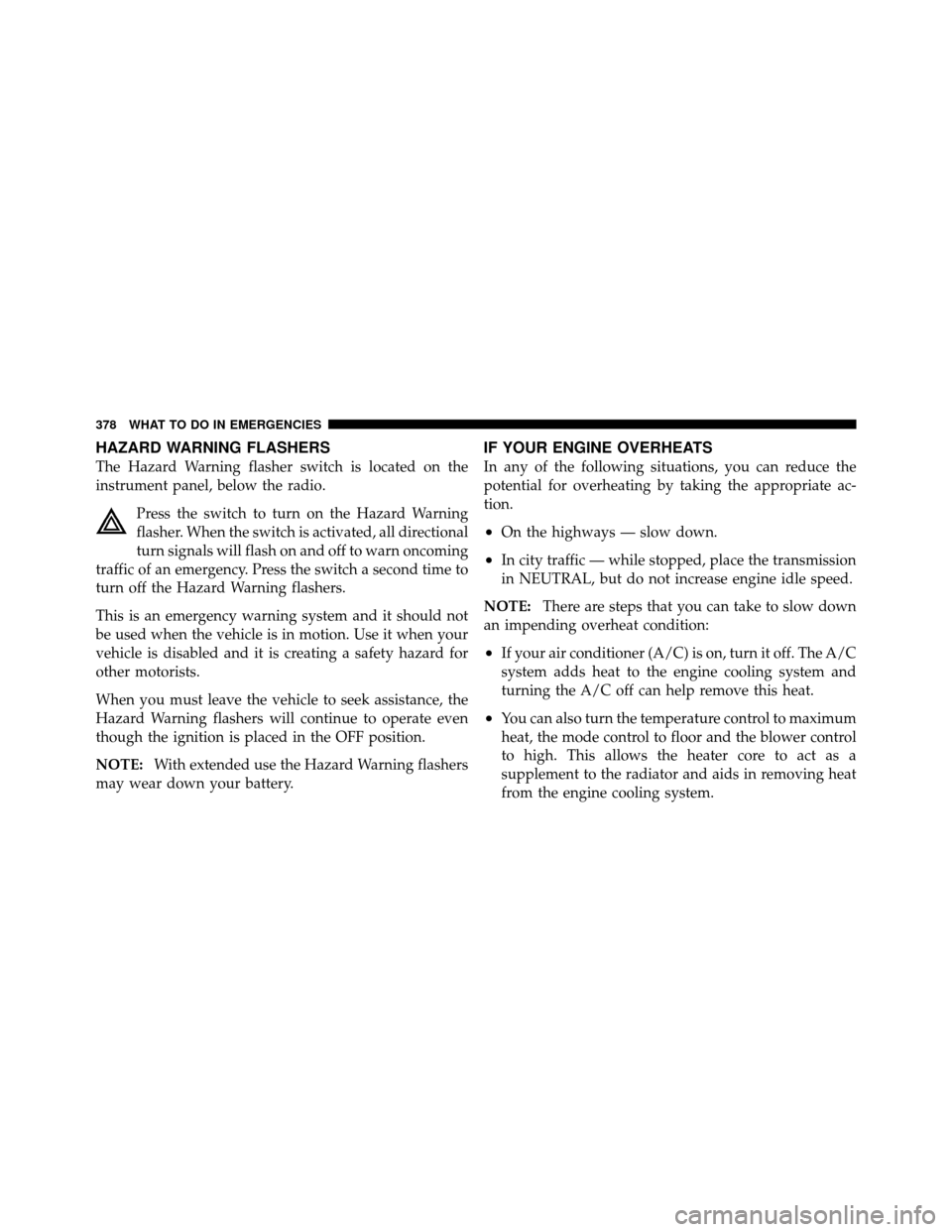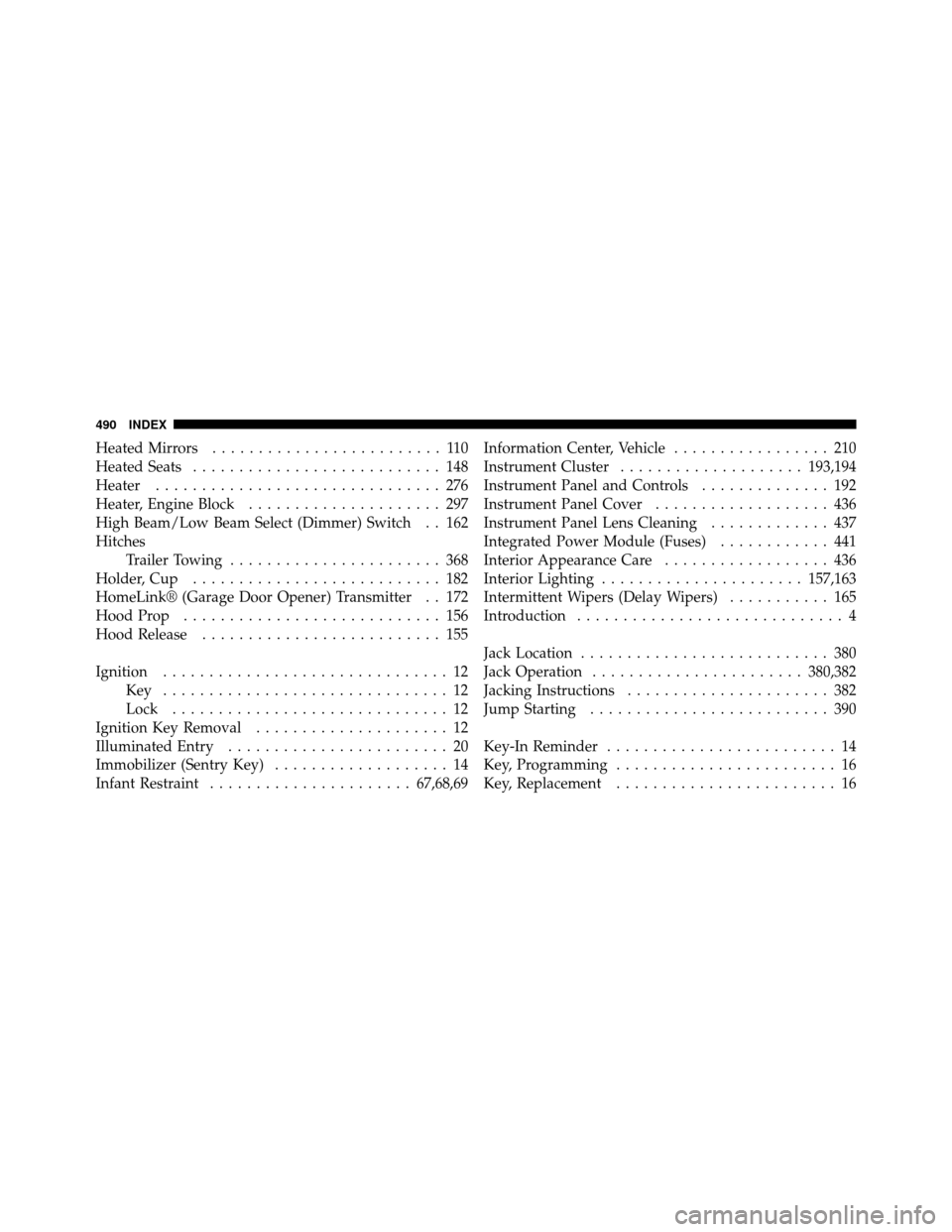Page 362 of 505

requirements of Material Standard MS-6395. MS-6395
contains additional requirements, developed during ex-
tensive fleet testing, to provide additional protection to
Chrysler Group LLC engines. Use MOPAR�or an
equivalent oil meeting the specification MS-6395.
Starting
The characteristics of E-85 fuel make it unsuitable for use
when ambient temperatures fall below 0°F (-18°C). In the
range of 0°F (-18°C) to 32°F (0°C), you may experience an
increase in the time it takes for your engine to start, and
a deterioration in driveability (sags and/or hesitations)
until the engine is fully warmed up.
NOTE: Use of the engine block heater (if equipped) is
beneficial for E-85 startability when the ambient tempera-
ture is less than 32°F (0°C).
Cruising Range
Because E-85 fuel contains less energy per gallon/liter
than gasoline, you will experience an increase in fuel
consumption. You can expect your miles per gallon
(mpg)/miles per liter and your driving range to decrease
by about 30%, compared to gasoline operation.
Replacement Parts
Many components in your Flexible Fuel Vehicle (FFV) are
designed to be compatible with ethanol. Always be sure
that your vehicle is serviced with correct ethanol com-
patible parts.
CAUTION!
Replacing fuel system components with non-ethanol
compatible components can damage your vehicle.
360 STARTING AND OPERATING
Page 380 of 505

HAZARD WARNING FLASHERS
The Hazard Warning flasher switch is located on the
instrument panel, below the radio.Press the switch to turn on the Hazard Warning
flasher. When the switch is activated, all directional
turn signals will flash on and off to warn oncoming
traffic of an emergency. Press the switch a second time to
turn off the Hazard Warning flashers.
This is an emergency warning system and it should not
be used when the vehicle is in motion. Use it when your
vehicle is disabled and it is creating a safety hazard for
other motorists.
When you must leave the vehicle to seek assistance, the
Hazard Warning flashers will continue to operate even
though the ignition is placed in the OFF position.
NOTE: With extended use the Hazard Warning flashers
may wear down your battery.
IF YOUR ENGINE OVERHEATS
In any of the following situations, you can reduce the
potential for overheating by taking the appropriate ac-
tion.
•On the highways — slow down.
•In city traffic — while stopped, place the transmission
in NEUTRAL, but do not increase engine idle speed.
NOTE: There are steps that you can take to slow down
an impending overheat condition:
•If your air conditioner (A/C) is on, turn it off. The A/C
system adds heat to the engine cooling system and
turning the A/C off can help remove this heat.
•You can also turn the temperature control to maximum
heat, the mode control to floor and the blower control
to high. This allows the heater core to act as a
supplement to the radiator and aids in removing heat
from the engine cooling system.
378 WHAT TO DO IN EMERGENCIES
Page 394 of 505

WARNING!
•Take care to avoid the radiator cooling fan when-
ever the hood is raised. It can start anytime the
ignition switch is on. You can be injured by
moving fan blades.
•Remove any metal jewelry such as watch bands or
bracelets that might make an inadvertent electrical
contact. You could be seriously injured.
•Batteries contain sulfuric acid that can burn your
skin or eyes and generate hydrogen gas which is
flammable and explosive. Keep open flames or
sparks away from the battery.
1. Set the parking brake, shift the automatic transmission
into PARK and turn the ignition to LOCK.
2. Turn off the heater, radio, and all unnecessary electri-
cal accessories. 3. Remove the protective cover over the remote positive
(+)
battery post. To remove the cover, press the locking
tab and pull upward on the cover.
4. If using another vehicle to jump-start the battery, park
the vehicle within the jumper cables reach, set the
parking brake and make sure the ignition is OFF.
Locking Tab
392 WHAT TO DO IN EMERGENCIES
Page 453 of 505
License Plate Lamp
1. Using a small screwdriver, press inward the locking
tab on the side of the lamp assembly and pull down on
the lamp assembly for removal.2. Pull bulb from socket, replace, and reinstall the lamp
assembly into place ensuring the locking tab is secure.
FLUID CAPACITIES
U.S.
Metric
Fuel (Approximate)
All Engines — (Except 2.4L PZEV) 16.9 Gallons64 Liters
2.4L PZEV (Partial Zero Emissions Vehicle) 18.5 Gallons70 Liters
Engine Oil with Filter
2.4L Engine (SAE 5W-20, API Certified) 4.5 Quarts4.4 Liters
3.6L Engine (SAE 5W-30, API Certified) 6 Quarts5.6 Liters
Cooling System*
2.4L Engine (MOPAR� Antifreeze/Coolant 5
Year/100,000 Mile Formula or equivalent) 7.7 Quarts
7.3 Liters
3.6L Engine (MOPAR� Antifreeze/Coolant 5
Year/100,000 Mile Formula or equivalent) 11.6 Quarts
11 Liters
* Includes heater and coolant recovery bottle filled to MAX level.
7
MAINTAINING YOUR VEHICLE 451
Page 488 of 505

DisposalAntifreeze (Engine Coolant) ............. 425
Engine Oil ......................... 412
Door Locks ............................. 30
Door Locks, Automatic .................... 32
Door Opener, Garage ..................... 172
Driver’s Seat Back Tilt .................... 151
Driving On Slippery Surfaces .................. 306
Through Flowing, Rising, or Shallow
Standing Water ...................... 307
E-85 Fuel ............................. 357
Electric Rear Window Defrost ............... 188
Electric Remote Mirrors ................... 109
Electrical Power Outlets ................... 178
Electronic Speed Control (Cruise Control) ...... 169
Electronic Stability Control (ESC) ............. 319
Electronic Vehicle Information Center (EVIC) .... 210Emergency Deck Lid Release
................ 38
Emergency Trunk Release ................... 38
Emergency, In Case of Jacking ............................ 380
Jump Starting ....................... 390
Overheating ........................ 378
Towing ............................ 397
Emission Control System Maintenance ......... 406
Engine ............................... 403
Air Cleaner ......................... 413
Block Heater ........................ 297
Break-In Recommendations .............. 78
Checking Oil Level ................... 409
Compartment ....................... 404
Compartment Identification ............. 404
Coolant (Antifreeze) ................ 422,452
Cooling ........................... 422
Exhaust Gas Caution ................80,357
Fails to Start ........................ 295
486 INDEX
Page 492 of 505

Heated Mirrors......................... 110
Heated Seats ........................... 148
Heater ............................... 276
Heater, Engine Block ..................... 297
High Beam/Low Beam Select (Dimmer) Switch . . 162
Hitches Trailer Towing ....................... 368
Holder, Cup ........................... 182
HomeLink® (Garage Door Opener) Transmitter . . 172
Hood Prop ............................ 156
Hood Release .......................... 155
Ignition ............................... 12
Key ............................... 12
Lock .............................. 12
Ignition Key Removal ..................... 12
Illuminated Entry ........................ 20
Immobilizer (Sentry Key) ................... 14
Infant Restraint ...................... 67,68,69Information Center, Vehicle
................. 210
Instrument Cluster .................... 193,194
Instrument Panel and Controls .............. 192
Instrument Panel Cover ................... 436
Instrument Panel Lens Cleaning ............. 437
Integrated Power Module (Fuses) ............ 441
Interior Appearance Care .................. 436
Interior Lighting ...................... 157,163
Intermittent Wipers (Delay Wipers) ........... 165
Introduction ............................. 4
Jack Location ........................... 380
Jack Operation ....................... 380,382
Jacking Instructions ...................... 382
Jump Starting .......................... 390
Key-In Reminder ......................... 14
Key, Programming ........................ 16
Key, Replacement ........................ 16
490 INDEX